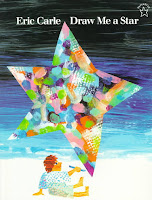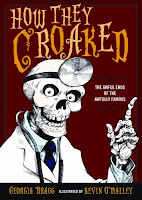 Summary
Summary There is an artist who is asked to draw a star. He draws a beautiful star who in return asks the artist to draw him a sun. The sun wants a tree; the tree wants a couple, the couple wants a house and so on. Eventually the cycle leads back to a star. In the end of the story, the artist goes on a journey with the star.
Impressions
At first, when I looked at the cover, I thought it was a
delightful children’s story and could not understand why it was on the challenge
list. Once I read the story, I came
across a drawing of a couple. It could
represent Adam and Eve. The couple did
not have clothing and some may find that offensive for children. I can see how many readers may take this as a
creation story and may oppose the illustration of the couple. I personally did not read that much into
it. I was a simple and well-illustrated
book. However, I may not purchase it for
any children in my house.
Reviews
A young boy is told (readers are not sure by whom) to “Draw me a
star.'' The star then requests that the boy draw it a sun; the sun asks for a
``lovely tree,'' and throughout his life the boy/man/artist continues to create
images that fill the world with beauty. The moon bids the now-elderly artist to
draw another star, and as the story ends, the artist travels across the night
sky'' hand-in-hand with the star. This book will appeal to readers of all ages;
its stunning illustrations, spare text, and simple story line make it a good
choice for story hour; but older children will also find it uplifting and
meaningful. Especially pleasing is a diagram within the story, accompanied by
rhyming instructions on how to draw a star: ``Down/ over/ left/ and right/ draw/
a star/ oh so/ bright.'' An inspired book in every sense of the word.
Larkin,
E. (1992). Draw me a star (Book
Review). School Library Journal, 3880.
A remarkable, quintessentially simple book encompassing Creation, creativity, and the cycle of life within the eternal. Introduced on the title page as a toddler drawing the first of five lines to make a star, an artist ages until, at the end, he's an old man who takes hold of a star to travel the night sky. Meanwhile, the first star says, "Draw me the sun"; the sun says, "Draw me a tree," and so on: woman and man; house, dog, cat, bird, butterfly, flowers, cloud; a rainbow arching over the middle-aged artist's whole creation; and back to the night and the stars. Carle's trademark style--vibrant tissue collage on dramatic white--is wonderfully effective in expressing the joy of creation, while the economy with which he conveys these universal ideas gives them extraordinary power. Yet the story is disarmingly childlike, concluding with an ingenuous letter from the author with instructions for drawing an eight-point star. Thanks be to the book for asking Carle to "draw" it! (Picture book. 3+)
Suggestions
In the back of the book Eric Carle shared how he learned how to draw a star. This was a special childhood memory for him. Students could talk with a family member and write down a favorite childhood memory. Students could also illustrate the memory.
In the back of the book Eric Carle shared how he learned how to draw a star. This was a special childhood memory for him. Students could talk with a family member and write down a favorite childhood memory. Students could also illustrate the memory.
References
Carle, E.
(1992). Draw me a star. Puffin.
http://3.bp.blogspot.com/_CzMpPsB3hnQ/TCNlDWJ4ylI/AAAAAAAAINE/XH3tnTdZn_Q/s1600/FC0698116321.jpg
.jpg)


